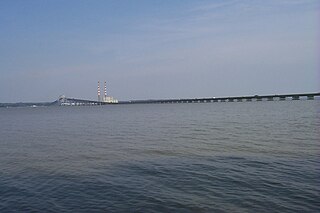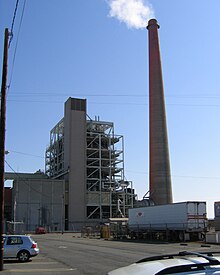
GenOn Energy, Inc., based in Houston, Texas, United States, is energy company that provides electricity to wholesale customers in the United States. The company is one of the largest independent power producers in the nation with more than 7,000 megawatts of power generation capacity across the United States using natural gas, fuel oil and coal. GenOn Energy was headquartered in the Reliant Energy Plaza in Downtown Houston. The company, formerly known as RRI Energy, acquired Mirant on December 3, 2010. The corporate names and logos of both RRI Energy and Mirant were retired.
Eversource Energy is a publicly traded, Fortune 500 energy company headquartered in Hartford, Connecticut, and Boston, Massachusetts, with several regulated subsidiaries offering retail electricity, natural gas service and water service to approximately 4 million customers in Connecticut, Massachusetts, and New Hampshire.

Southern California Edison (SCE), the largest subsidiary of Edison International, is the primary electric utility company for much of Southern California. It provides 15 million people with electricity across a service territory of approximately 50,000 square miles. However, the Los Angeles Department of Water and Power, San Diego Gas & Electric (SDG&E), Imperial Irrigation District, and some smaller municipal utilities serve substantial portions of the southern California territory. The northern part of the state is generally served by the Pacific Gas & Electric Company of San Francisco. Other investor-owned utilities (IOUs) in California include SDG&E, PacifiCorp, Bear Valley Electric, and Liberty Utilities.

Exelon Corporation is a public utility headquartered in Chicago, Illinois, and incorporated in Pennsylvania. Exelon is the largest electric parent company in the United States by revenue and is the largest regulated electric utility in the United States with approximately 10 million customers. The company is ranked 99th on the Fortune 500.

Constellation Energy Corporation is an American energy company headquartered in Baltimore, Maryland. The company provides electric power, natural gas, and energy management services. It has approximately two million customers across the continental United States.

FirstEnergy Corp is an electric utility headquartered in Akron, Ohio. It was established when Ohio Edison merged with Centerior Energy in 1997. Its subsidiaries and affiliates are involved in the distribution, transmission, and generation of electricity, as well as energy management and other energy-related services. Its ten electric utility operating companies comprise one of the United States' largest investor-owned utilities, based on serving 6 million customers within a 65,000-square-mile (170,000 km2) area of Ohio, Pennsylvania, West Virginia, Virginia, Maryland, New Jersey, and New York. Its generation subsidiaries control more than 16,000 megawatts of capacity, and its distribution lines span over 194,000 miles. In 2018, FirstEnergy ranked 219 on the Fortune 500 list of the largest public corporations in the United States by revenue.

NRG Energy, Inc. is an American energy company, headquartered in Houston, Texas. It was formerly the wholesale arm of Northern States Power Company (NSP), which became Xcel Energy, but became independent in 2000. NRG Energy is involved in energy generation and retail electricity. Their portfolio includes natural gas generation, coal generation, oil generation, nuclear generation, wind generation, utility-scale generation, and distributed solar generation. NRG serves over 7 million retail customers in 24 US states including Texas, Connecticut, Delaware, Illinois, Maryland, Massachusetts, New Jersey, New York, Pennsylvania, Ohio; the District of Columbia, and eight provinces in Canada.
Trinidad and Tobago Electricity Commission (T&TEC) is the sole retailer of electricity in Trinidad and Tobago. It is responsible for the design, construction, operation and maintenance of the country's electrical transmission and distribution network. The utility supplies electric power to customers on both islands via a single interconnected grid. Electrical energy is widely been purchased, metered and feed into the national grid from independent power producers. These producers are the Power Generation Company of Trinidad and Tobago (PowerGen) giving a total of 1,344 MW, Trinidad Generation Unlimited (TGU) giving 720MW and Trinity Power Ltd. giving 225 MW. All power stations in Trinidad and Tobago are fueled by hydrocarbons.

Dickerson is an unincorporated community in Montgomery County, Maryland. It is on Maryland Route 28, between Sugarloaf Mountain and the Potomac River. It is a community near the town of Poolesville, Maryland. Dickerson is 61.5 square miles (159 km2).
Popes Creek is a 3.4-mile-long (5.5 km) stream in Charles County, Maryland and a tributary of the Potomac River.

The Morgantown Generating Station is a 1,477 MW electric generating plant owned by GenOn Holdings LLC., located in the unincorporated town of Newburg, Maryland, near Morgantown, on the Potomac River. The station was built in 1970.

The Dickerson Generating Station is an 853 MW electric generating plant owned by NRG Energy, located approximately two miles west of Dickerson, Maryland, on the eastern banks of the Potomac River.

The Chalk Point Generating Station is an electricity-generating plant, comprising oil and natural gas fired units, owned by NRG Energy, located near the town of Eagle Harbor, Maryland, United States, on the Patuxent River.
The Southern Maryland Electric Cooperative (SMECO) is an electric distribution cooperative which is headquartered in Hughesville, Maryland, United States. SMECO serves approximately 161,000 customers in Calvert, Charles, Prince George's, and St. Mary's counties of southern Maryland. Under its rules as a nonprofit cooperative, SMECO passes on its costs to its customer-members without markup or profit.
Evergy, Inc. is an American investor-owned utility (IOU) with publicly traded stock with headquarters in Topeka, Kansas, and in Kansas City, Missouri. The company was formed from a merger of Westar Energy of Topeka and Great Plains Energy of Kansas City, parent company of Kansas City Power & Light. Evergy is the largest electric company in Kansas, serving more than 1.7 million residential, commercial and industrial customers in Kansas and Missouri. Its more than 40 power plants have generating capacity of 16,000 megawatt electricity in Kansas and Missouri. Service territory covers 28,130 square miles (72,900 km2) in east Kansas and west Missouri. It owns more than 10,100 miles (16,300 km) of transmission lines and about 52,000 miles (84,000 km) of distribution lines.

The Potrero Generating Station was a natural gas and diesel burning electricity generating station owned by Mirant and located on a 23-acre (9.3 ha) site in Potrero Point, San Francisco, California. The plant's primary power source was a 206 MW, natural gas burning steam turbine providing baseload power and referred to as "Unit 3". In addition, three 52 MW peaking power diesel generators provided additional power during times of highest consumption. Since the closure of the Hunters Point Power Plant in 2006, Potrero was the last remaining fossil fuel power plant within the confines of San Francisco, with capacity to provide approximately 1/3 of the city's peak electrical power needs.
The Canal Generating Plant is a petroleum and natural gas electrical power station in Sandwich, Massachusetts. Canal 1, a baseload unit, began operation in 1968 and was for many years the most efficient oil burning plant in the US. Canal 2, a cycling unit began operation in the mid-1970s. The plant was bought by Mirant in 1999, now GenOn Energy Holdings division of NRG Energy. It is located on Cape Cod Canal. In its heyday, the Canal plant generated the vast majority of the Cape's power, but today functions only as a peaking plant.
Talen Energy is an independent power producer founded in 2015. It was formed when the competitive power generation business of PPL Corporation was spun off and immediately combined with competitive generation businesses owned by private equity firm Riverstone Holdings. Following these transactions, PPL shareholders owned 65% of Talen's common stock and affiliates of Riverstone owned 35%. As a condition for FERC approval Talen agreed to divest approximately 1,300 megawatts of generating assets in the PJM Interconnection Region to mitigate FERC's competitiveness concerns. On December 6, 2016, Riverstone Holdings completed the purchase of the remaining 65% of Talen's common stock, making it a privately owned company.

Gateway Generating Station (GGS), formerly Contra Costa Unit 8 Power Project, is a combined-cycle, natural-gas-fired power station in Contra Costa County, California, which provides power to half a million customers in northern and central California. Gateway Generating Station is on the southern shore of the San Joaquin River, in Antioch, and is one of more than ten fossil-fuel power plants in Contra Costa County.













